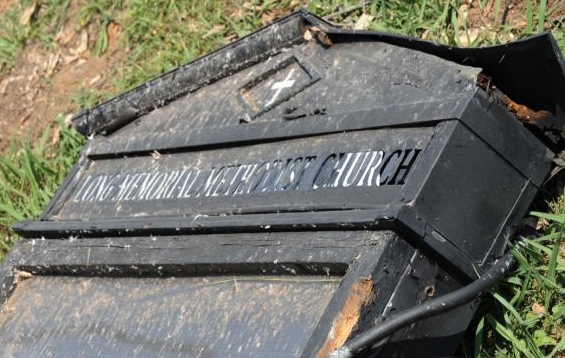Sin, racism and a killer tornado?
 The following story is a journalistic nightmare. Please understand that I am not saying that it is poorly reported and written. I would not be in a position to say that. In fact, I do not believe that.
The following story is a journalistic nightmare. Please understand that I am not saying that it is poorly reported and written. I would not be in a position to say that. In fact, I do not believe that.
What I am saying is that this is the kind of story that is a nightmare for journalists to cover. It's a story with powerful emotions that are linked to mixture of fact and rumors. Just about the only thing that people agree on, in this story, is that they are not in agreement about the basic facts. Oh, but there is this -- they also agree that it may not be possible to ever know all of the facts.
In the center of this New York Times report stands a mainline church in the deep South and an accusation of hellish, even deadly racism. But is it the church that is being accused or simply one nameless woman who may or may not have been part of the church?
It's a nightmare, I tell you. And absolute riveting. Here is the top of the report:
CORDOVA, Ala. -- Everybody in town heard about it.
It was discussed openly and in whispers, over the phone and in the church pews. When it was brought up at school, the curious were quickly shushed. Eventually, the whole thing got pushed aside by other concerns, a bit of nastiness better forgotten, or judged never to have occurred at all.
But Madison Phillips says it is true. He says that he and his mother, Annette Singleton, both black, were turned away from a church shelter by a white woman on the afternoon of April 27, the day of the tornadoes. And within hours, Ms. Singleton and two of Madison’s young friends, who had been huddling with him in his house within yards of that church, were dead.
The details simply get more and more complex:
There is little agreement about what happened, or whether it happened at all, and the full truth may never be known. Madison says he did not recognize the woman. The only other witness, an older man who is known around town for his frequent run-ins with the law and fondness for alcohol, is saying that he did not see the situation firsthand, but only talked to Madison’s mother as she was coming and going.
The minister at the church, the Rev. Ryan Rosser, said the doors were open all day long to anyone seeking shelter; indeed, there were black utility workers among the 45 or so people in the church basement during the second tornado. Mr. Rosser said that none of the people he had spoken with who were there recalled anything like what Madison describes happening.
As you would expect, in a small town, there are many versions of the story going around. However, the Times stresses that one version has stayed the same -- the son's version.
The institution at the center of the story is the historic Long Memorial United Methodist Church (which itself was ravaged by the twister), which only adds another wrinkle to the drama. In most Southern towns, the pews in the United Methodist church would, along with those at the local Episcopal parish, represent a more elite and progressive segment of the local population. As the old saying goes, high-school grads are Baptists, college-grads are Methodists, the doctors and lawyers are Episcopalians, etc. etc.
OK, I will ask the question: Would the church itself have played a larger, more ominous role in this Times story if someone at a Southern Baptist church had been accused of this act? Also, has there been any attempt to identify the woman? All the story says is that Ms. Singleton approached "a woman coming out of the church" and asked "whether the church was being used as a shelter. ... The woman told her it was not."
Like I said, it is an agonizing and riveting story. How to end this tragic, mysterious and frighting story?
On a recent weekday, at a soup kitchen for tornado survivors at the Free Will Baptist Church, whites and blacks worked alongside one another. Everyone who was asked had heard the story. Some believed it, and were disgusted by it. Others said with so many rumors flying around, they were inclined to just let it go.
Loudelia Branch, the wife of the city council member, lamented that, pointing out what was undeniably true.
“She existed,” she said of Ms. Singleton. “It’s not like she did not exist.”
Read it all.
PHOTO: The fallen sign in the ruins of the historic Long Methodist church, from the FEMA.org photo library.